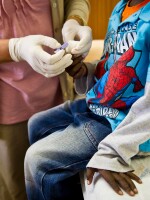Millions of people around the world are living with HIV, thanks to drug regimens that suppress the virus. Now there's a new push to eliminate HIV from patients' bodies altogether. That would be a true cure.
We're not there yet. But a report in Science Translational Medicineis an encouraging signpost that scientists may be headed in the right direction.
Forty-three patients got immune cells designed to attack and kill cells infected with HIV. As long as 16 years later, these genetically engineered T cells are still circulating in their bloodstreams. And there's been no sign the gene therapy caused any cancers, or is likely to.
That may seem like a modest victory. After all, there's no evidence yet that the gene therapy did what it's supposed to — eliminate the reservoir of HIV hiding in the patients' cells, waiting to emerge as soon as patients stop taking their antiviral drugs.
But to scientists in HIV and gene therapy research, it's a highly encouraging indicator. "We're not hitting a home run. This is a single," AIDS researcher Pablo Tebas of the University of Pennsylvania tells Shots.
"It looks like if you do this, it's going to be safe because we have not seen any toxicity in 16 years," he says. "And two, the genetically modified cells are still circulating. They perpetuate. Those are two important things this study is telling us."
Tebas is not an author of the study, but he works with the Penn researchers who did the work. They were unavailable for comment.
Previous attempts at this kind of gene therapy, called adoptive T cell transfer, have been plagued by cancers that can arise when the genes introduced into engineered cells insert themselves next to growth-promoting genes. In other cases the engineered cells have died out before they have a sustained positive effect.
Another hopeful sign that engineered T cells can actually work came from the same Penn group last summer. They reported on a single patient with advanced chronic lymphocytic leukemia who had failed a succession of chemotherapy treatments.
The Penn researchers injected the patient with some of his own T cells that had been engineered to home in on leukemia cells, which bear a distinctive surface protein. Within a month, doctors could find no leukemia cells in the patient's bone marrow.
A year and nine months after the gene therapy treatment, a Penn spokeswoman says the patient remains well and apparently free of disease.
In the HIV patients, their own T cells are engineered to search out and destroy cells infected with the virus.
On the strength of evidence the treatment is safe and lasting, the Penn researchers have launched a trial with an updated version of the gene therapy. So far they've enrolled two patients out of an expected two dozen.
This time, Tebas says, they hope to see evidence that the engineered T cells are actually reducing patients' hidden reservoirs of HIV infection. Or — dare they hope? — eliminating them altogether.
Copyright 2020 NPR. To see more, visit https://www.npr.org.



